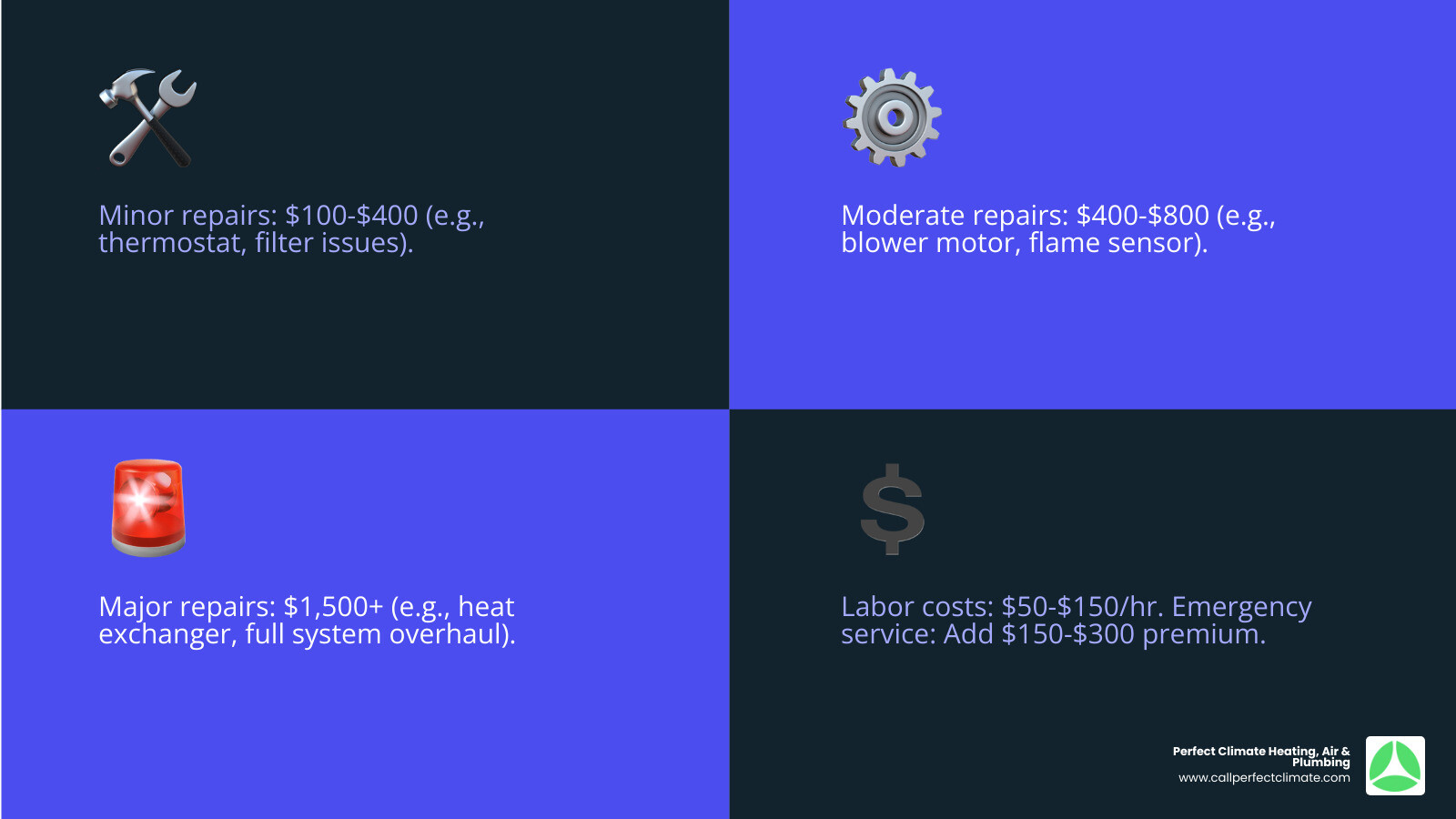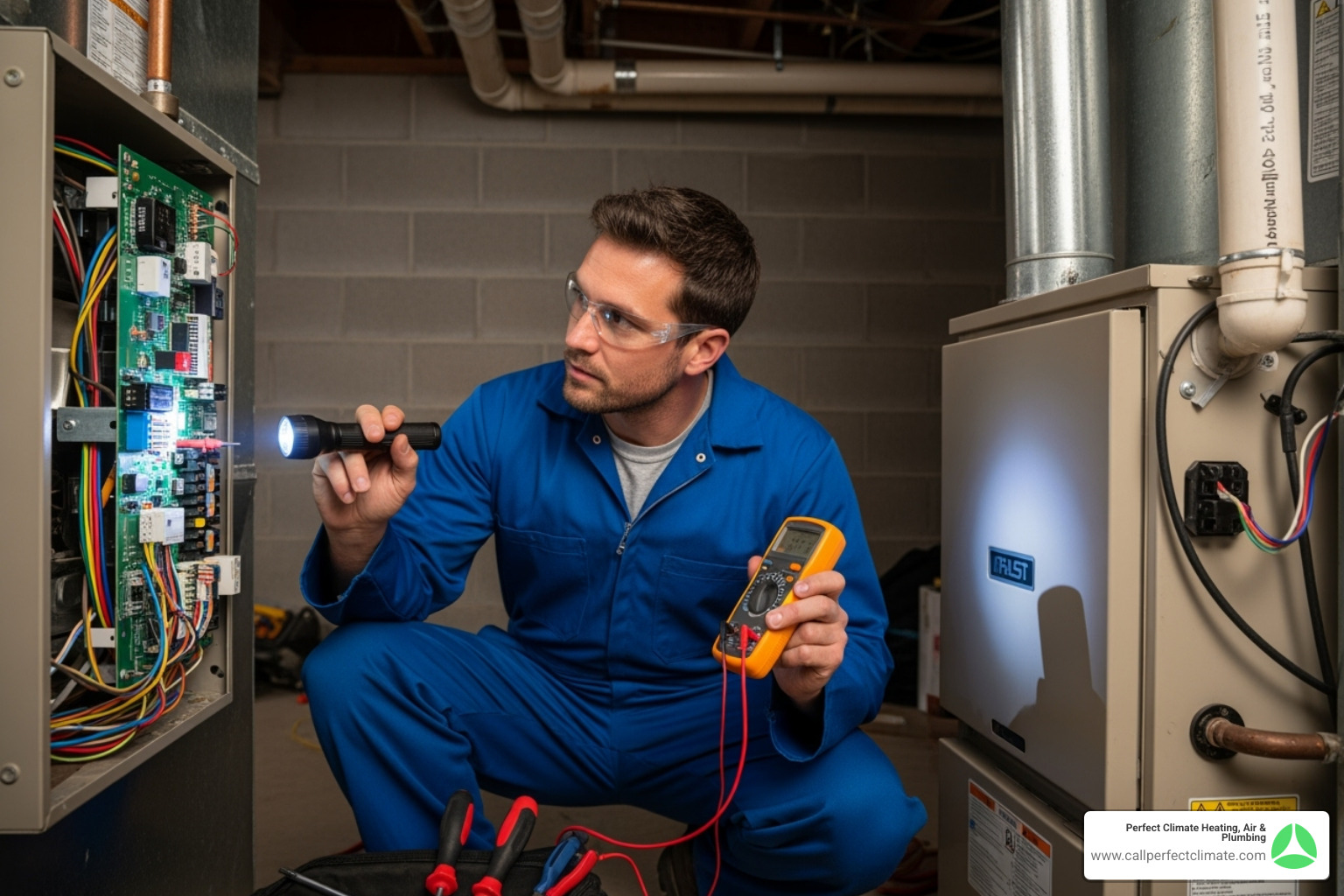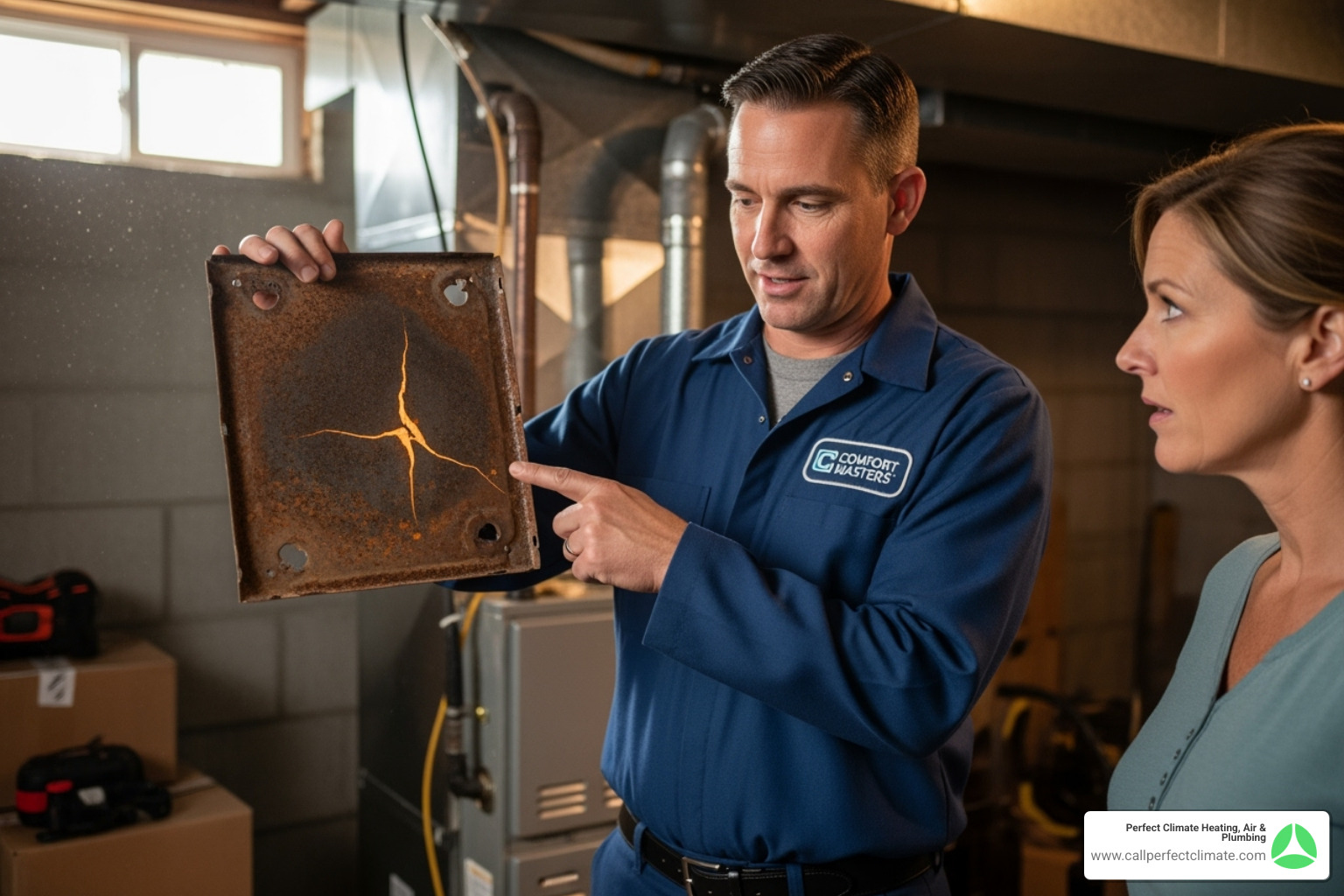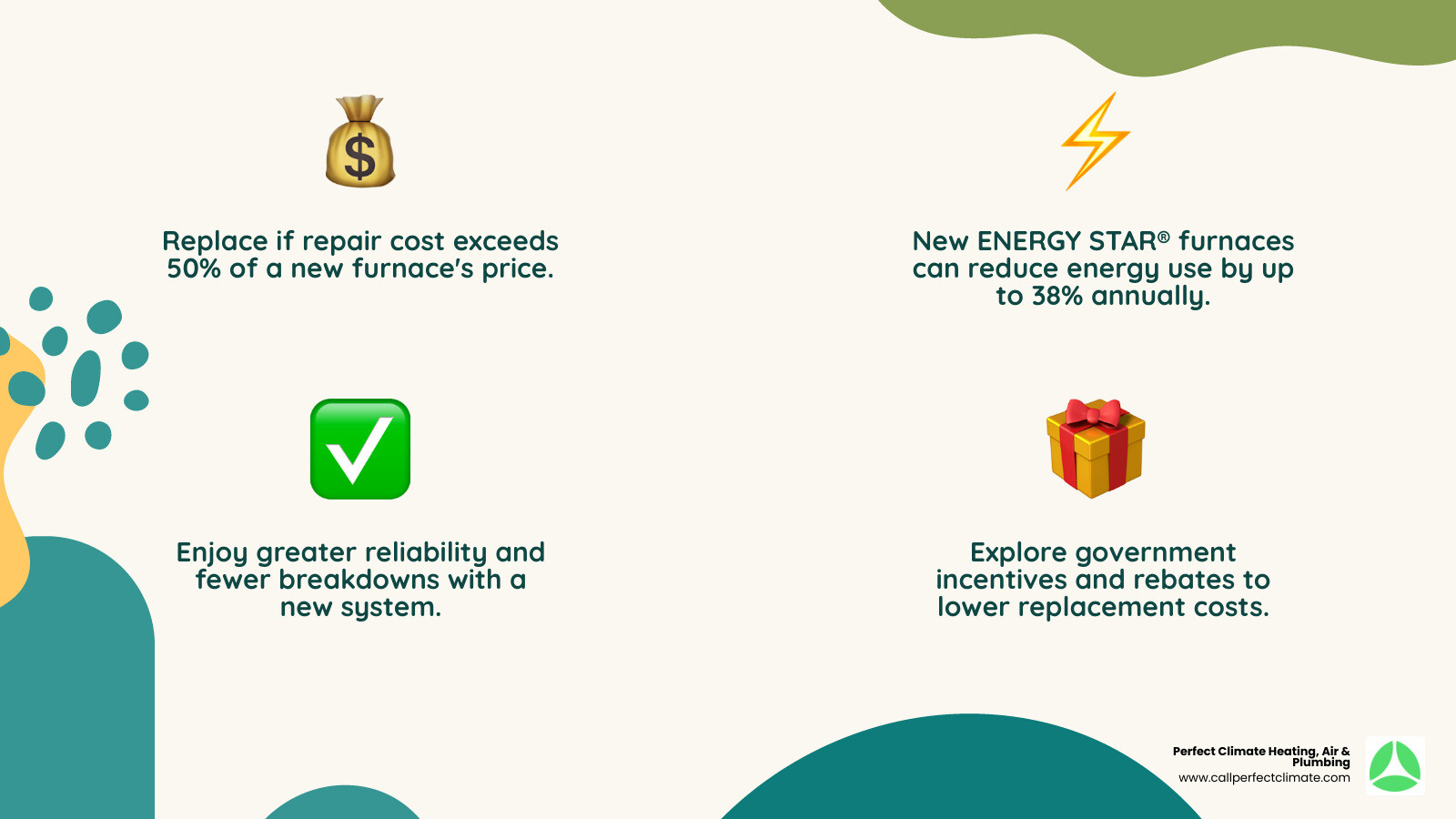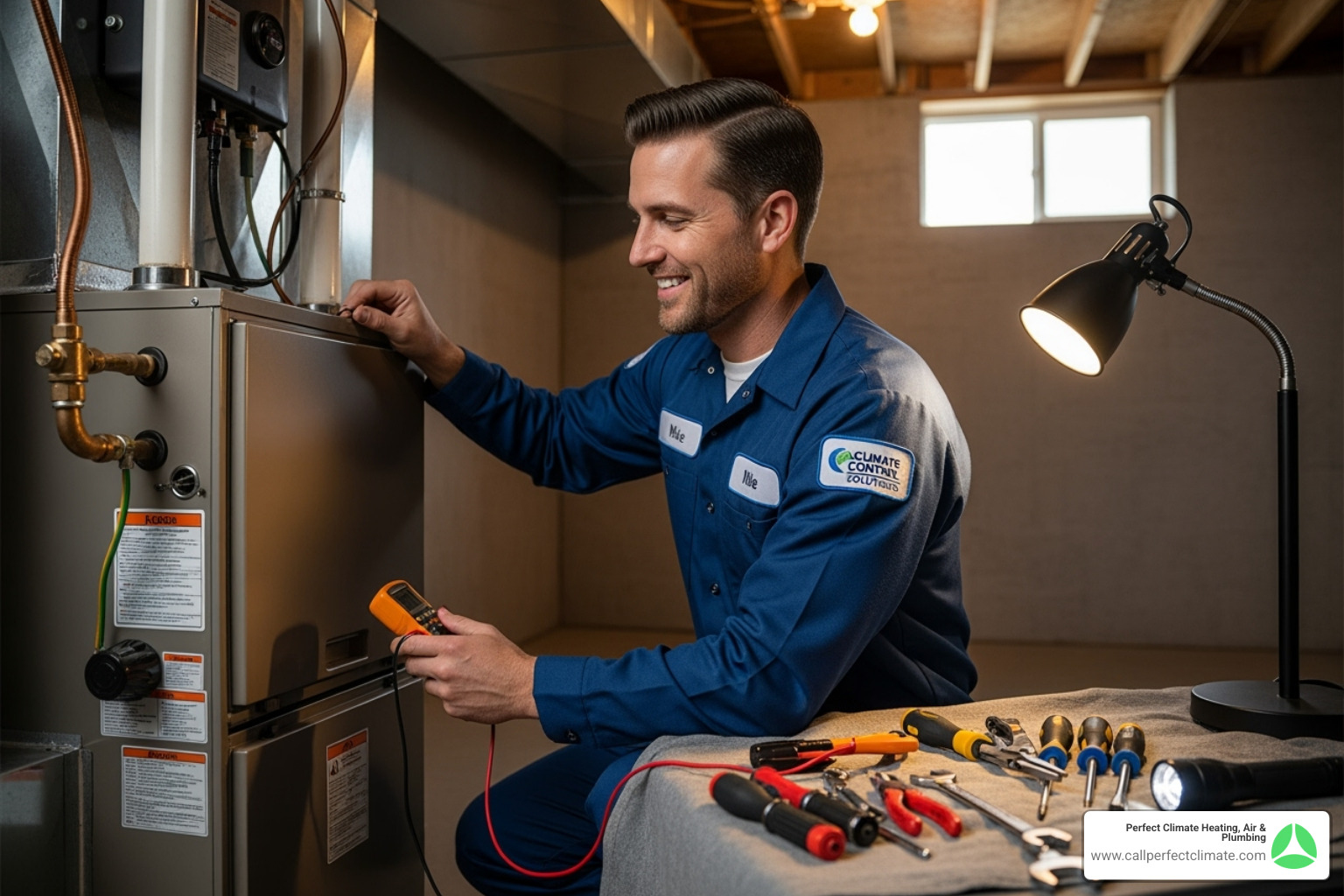When Your Furnace Breaks Down: What You Need to Know About Costs
Furnace repair cost can quickly become a major concern when your heating system fails on a cold winter day. Most homeowners spend between $132 and $501 for furnace repairs, with the national average around $317.
Quick Cost Overview:
- Minor repairs: $100-$400 (thermostat, filter issues)
- Moderate repairs: $400-$800 (blower motor, flame sensor)
- Major repairs: $1,500+ (heat exchanger, complete system overhaul)
- Labor costs: $50-$150 per hour
- Emergency service: Additional $150-$300 premium
When your furnace decides to break down, you’re facing more than just an inconvenience. You’re looking at repair bills that can range from a simple fix to a significant expense that makes you question whether repair or replacement makes more sense.
The complexity of modern furnaces means that diagnosing the problem correctly is crucial. A faulty thermostat might cost under $200 to fix, while a cracked heat exchanger could run several thousand dollars. Understanding these cost differences helps you make informed decisions when talking with repair technicians.
Emergency repairs during peak winter months often come with premium pricing. After-hours service calls can double your labor costs, making it even more important to understand what you’re paying for and why.
Breaking Down the Average Furnace Repair Cost
Picture this: you wake up to a chilly house and find your furnace has decided to take an unscheduled vacation. Your first thought? “How much is this going to cost me?” It’s a fair question, and the answer isn’t always straightforward.
The national average furnace repair cost sits around $317, but that’s just the middle ground. Your actual bill could land anywhere in the typical range of $132 to $501, depending on what’s actually wrong with your system.
Minor repairs are the gentle nudges your furnace sometimes needs. Think thermostat adjustments, filter replacements, or simple electrical fixes. These usually fall between $100 and $400 and can often get you back up and running the same day.
Moderate repairs require a bit more detective work and elbow grease. When your flame sensor gets cranky or your blower motor starts acting up, you’re looking at the $400 to $800 range. These fixes take more time and expertise, but they’re still much more affordable than starting fresh with a new system.
Then we have the big players – major repairs that can hit $1,500 or more. These are the repairs that make you pause and wonder if it’s time to say goodbye to your old furnace altogether. Heat exchanger replacements and complete system overhauls fall into this category.
Understanding what commonly goes wrong can help you prepare mentally and financially. If you’re curious about the usual suspects that cause furnace headaches, check out our guide on Common Issues Requiring Furnace Repair.
Understanding the Typical Furnace Repair Cost for Common Parts
Every furnace is like a well-orchestrated team – when one player sits out, the whole game changes. The furnace repair cost largely depends on which team member needs attention and whether they need coaching or complete replacement.
| Furnace Part | Typical Repair/Replacement Cost Range | Notes |
|---|---|---|
| Ignitor | $150 – $500 | Common failure point; costs more during emergency calls |
| Flame Sensor | $75 – $250 | Often just needs a good cleaning rather than replacement |
| Blower Motor | $150 – $2,000 | Simple repairs are cheaper; full replacement hits the higher end |
| Heat Exchanger | $500 – $1,500 | Critical safety component; cracked units pose carbon monoxide risks |
| Control Board | $200 – $600 | Cost varies with your furnace’s complexity and efficiency rating |
| Gas Valve | $200 – $1,000 | Essential for safe gas flow to your burners |
| Thermostat | $100 – $600 | Wiring fixes are cheaper; smart thermostats cost more |
The ignitor is often the troublemaker – it’s responsible for lighting your furnace, and when it fails, you’re left in the cold. The flame sensor, on the other hand, is usually just dirty and needs a gentle cleaning rather than complete replacement.
Your blower motor is the workhorse that circulates warm air throughout your home. When it starts struggling, you might notice weak airflow or strange noises. The heat exchanger is the heavyweight – it’s crucial for safety, and a cracked one is a serious concern that requires immediate attention.
The control board acts like your furnace’s brain, coordinating all the different components. When it goes haywire, your entire system can act unpredictably. Meanwhile, your thermostat is the messenger between you and your furnace – sometimes the issue is as simple as recalibrating the communication.
How Labor and Emergency Fees Affect Your Furnace Repair Cost
Here’s where things get interesting – and sometimes expensive. Beyond the actual parts, a big chunk of your furnace repair cost comes from the skilled hands that fix everything and, unfortunately, the timing of when things go wrong.
Most HVAC companies charge a standard service call fee between $80 and $150. Think of this as the cover charge for getting a professional to your door and figuring out what’s actually wrong. The good news? Many companies, including us at Perfect Climate, often apply this fee toward your total repair cost if you decide to move forward with the work.
Once we know what needs fixing, hourly labor rates typically run $50 to $150 per hour. Our certified technicians in Haubstadt, Evansville, Princeton, and Newburgh work efficiently to respect both your time and your wallet.
But here’s where Murphy’s Law really kicks in – furnaces seem to have a sixth sense for breaking down at the worst possible moments. After-hours service, weekend calls, and holiday rates can add an extra $150 to $300 to your bill. During true emergencies, hourly rates can jump to $150 to $215, making your total emergency furnace repair cost anywhere from $300 to $1,200.
Nobody likes paying emergency rates, but when you’re facing a freezing house in the middle of winter, getting immediate help becomes priceless. If you ever find yourself in this stressful situation, our guide on What to Do When You Need Emergency Furnace Repair can help you steer the chaos and make smart decisions under pressure.
Key Factors That Influence Your Final Bill
When it comes to furnace repair cost, the broken part is just one piece of the puzzle. Several other factors can make your bill swing from manageable to “ouch, that hurts.” Let’s walk through what really drives those costs up or down.
Your furnace’s age is probably the biggest wild card in this equation. Think of it like your old car – the older it gets, the more surprises it has in store for you. Furnaces that have been faithfully heating your home for 15 years or more start getting finicky. Parts wear out more frequently, and here’s the kicker: finding replacement parts for older models can be like hunting for buried treasure.
When your technician has to track down a specific component for a furnace that’s been discontinued, you’re not just paying for the part – you’re paying for the detective work too. Sometimes these vintage parts come with premium price tags that would make your wallet weep.
Warranty coverage can be your saving grace or your blind spot. If your furnace is still young enough to be covered under warranty (usually 5 to 10 years for parts), you might only need to cover labor costs. That’s a huge relief for your budget. But here’s the catch – most warranties don’t cover labor unless you’ve got an extended warranty or service plan. Always double-check what’s actually covered before assuming you’re in the clear.
The type of furnace humming away in your basement also plays a starring role in your final bill. Electric furnaces tend to be the gentle giants of the heating world – simpler systems usually mean simpler (and cheaper) repairs. Gas furnaces, which are practically everywhere here in Indiana, have more moving parts and complex systems to keep that flame burning safely. Oil furnaces fall somewhere in the middle of the complexity spectrum.
Job complexity and parts availability round out the major cost drivers. A quick adjustment or cleaning is like changing a light bulb – straightforward and affordable. But when your technician needs to play detective with a mysterious electrical gremlin or source a rare component, those hours add up fast.
At Perfect Climate Heating, Air & Plumbing, we believe in keeping you in the loop every step of the way. No surprise bills, no confusing jargon – just honest communication about what needs fixing and what it’ll take to get your home cozy again.
Repair vs. Replace: Making the Smart Financial Decision
When you’re staring at a hefty furnace repair cost, that familiar question starts nagging at you: Should I fix this old thing or just bite the bullet and get a new one? It’s one of those decisions that keeps homeowners up at night, especially when the repair estimate makes your wallet feel significantly lighter.
Here’s a helpful guideline that many HVAC professionals swear by: the 50% rule. If your repair cost is more than half the price of a brand-new furnace, replacement usually makes more financial sense. Think of it like this – would you spend $2,000 fixing a car that’s only worth $3,000? Probably not.
Age matters more than you might think. Most furnaces live good, productive lives for about 15 to 20 years. Once your system hits that 15-year mark, it’s entering its golden years – and like many of us, it might start having more aches and pains. An older furnace that needs major repairs is often telling you it’s ready for retirement.
Take a moment to think about how often you’ve been calling for repairs lately. If you’re on a first-name basis with your HVAC technician because they’re at your house every few months, that’s a red flag. Frequent breakdowns are your furnace’s way of waving a white flag. Each service call adds up, and those costs can quickly exceed what you’d spend on a new, reliable system.
Another telltale sign? Rising energy bills that seem to creep up every month, even though you haven’t changed your heating habits. When your furnace starts working overtime just to keep you comfortable, it’s burning through fuel like there’s no tomorrow. This declining efficiency is costing you money every single month. For a complete list of warning signs, check out our guide on Furnace Replacement Time Signs.
Modern furnaces are incredibly impressive when it comes to energy efficiency. They’re measured by something called Annual Fuel Utilization Efficiency (AFUE) – basically, how much of your fuel actually gets converted into heat for your home rather than disappearing up the chimney. You can learn more about AFUE ratings from Natural Resources Canada.
Upgrading to an ENERGY STAR®-rated furnace can be a game-changer for your monthly bills. These high-efficiency units can slash your energy use by up to 38%, potentially saving you hundreds of dollars every year. That’s money that stays in your pocket instead of going up in smoke. You can explore more about these efficient systems at Natural Resources Canada’s furnace guide.
Don’t forget to look into government incentives that might be available in your area. Many programs offer rebates for upgrading to high-efficiency systems, which can significantly reduce the upfront cost of replacement. These incentives can sometimes tip the scales in favor of replacement, even when you’re on the fence.
At Perfect Climate Heating, Air & Plumbing, we specialize in advanced technologies like geothermal and solar heating solutions that can offer even greater long-term savings. Our energy audits help homeowners in Haubstadt, Evansville, Princeton, and Newburgh understand exactly how their current system is performing and where they might save money with an upgrade. Sometimes the numbers tell a clear story – and sometimes that story is that it’s time to say goodbye to your old faithful furnace.
How to Manage Costs and Choose the Right Technician
When your furnace starts acting up, managing the furnace repair cost doesn’t have to feel like navigating a maze blindfolded. With some smart strategies and the right approach, you can keep expenses reasonable while ensuring you get quality service that actually fixes the problem.
The golden rule when facing a significant repair bill is getting multiple quotes. Think of it like shopping for a car – you wouldn’t buy the first one you see without comparing options. Reach out to two or three reputable HVAC companies and compare their proposals side by side. This gives you a clearer picture of what’s fair pricing in your area.
But here’s the key: make sure you’re asking for detailed estimates that break down everything. You want to see exactly what you’re paying for – parts, labor, service fees, and any additional charges. This transparency helps you compare apples to apples rather than guessing what’s included in a lump sum quote.
Now, when your furnace is on the fritz and you’re staring at a potentially hefty repair bill, the thought of DIY repair might seem tempting. After all, how hard could it be, right? While changing a furnace filter is definitely something most homeowners can handle, most furnace repairs venture into territory that’s best left to the professionals.
Here’s the reality: furnaces involve gas lines, high-voltage electricity, and intricate components that require specialized knowledge. Attempting repairs without proper training and tools creates serious safety risks including gas leaks, electrical shocks, and carbon monoxide poisoning. Plus, a well-intentioned DIY attempt gone wrong can cause additional damage, turning what might have been a moderate repair into a major expense. For your safety and your wallet’s sake, understanding the Professional Furnace Repair Importance is crucial.
The Power of Prevention: How Maintenance Saves You Money
Here’s a truth that might surprise you: the best way to manage furnace repair cost is to avoid major repairs altogether. Think of your furnace like your car – regular maintenance isn’t just an expense, it’s an investment that prevents those heart-stopping repair bills.
Annual tune-ups are your furnace’s best friend and your budget’s guardian angel. During these professional inspections, a skilled technician cleans components, checks electrical connections, tests safety features, and lubricates moving parts. They catch small issues before they snowball into expensive emergencies.
The beauty of preventive maintenance is that it works on multiple levels. It helps prevent costly breakdowns, extends your furnace’s lifespan, and keeps it running efficiently. An efficiently running furnace uses less energy, which shows up as savings on your monthly utility bills.
One of the simplest yet most effective maintenance tasks is regularly changing filters. A clean filter allows proper airflow, while a clogged one forces your furnace to work harder. This extra strain increases energy consumption and puts unnecessary stress on components like the blower motor, potentially leading to premature failure and expensive repairs.
At Perfect Climate Heating, Air & Plumbing, our preventive maintenance programs are designed to keep your system running smoothly and can significantly Improve Efficiency with Heating Repair, saving you money over the long haul.
What to Look For in an HVAC Company
Choosing the right HVAC company can make the difference between a fair furnace repair cost and feeling like you’ve been taken for a ride. You’re trusting someone with your home’s comfort and safety, so it’s worth being selective.
Licensed and insured should be your starting point – this isn’t negotiable. A licensed company means their technicians meet industry standards, while insurance protects you if something goes wrong during the repair. Always ask to see proof of both.
Positive reviews tell you a lot about what to expect. Check Google, industry websites, and ask neighbors for recommendations. A company with consistently satisfied customers is usually a safe bet. Pay attention to how they respond to any negative reviews too – it shows their character.
Years of experience often translates to expertise you can trust. A company that’s been around the block has likely encountered every type of furnace problem imaginable. Our team has decades of combined experience serving homeowners throughout Haubstadt, Evansville, Princeton, Newburgh, and the surrounding Indiana communities.
Transparent pricing is essential for managing costs effectively. Reputable companies provide clear, detailed estimates upfront and explain what each charge covers. They won’t pressure you into immediate decisions or give you vague estimates that mysteriously grow once the work begins.
Look for certified technicians with credentials like NATE (North American Technician Excellence). These certifications show they’ve met rigorous industry standards for knowledge and skill. You’ll also want a company that offers reliable availability, especially during peak heating season when you need service most.
Finally, don’t underestimate good old-fashioned customer service. A friendly, responsive, and professional team makes the entire experience better and often indicates the quality of work you can expect.
For more detailed guidance on selecting a trusted provider, check out our comprehensive guide: 5 Tips on Choosing a Heating Repair Company in Poseyville IN.
Frequently Asked Questions about Furnace Repair
When your heating system starts acting up, you probably have a million questions running through your mind. We get it – furnace repair cost decisions can feel overwhelming, especially when you’re trying to figure out if that old furnace is worth saving or if it’s time to say goodbye.
Let’s tackle some of the most common questions we hear from homeowners in our community.
How long does a typical furnace last?
Most furnaces will keep you warm for 15 to 20 years on average, though some can stretch to 30 years with exceptional care. Think of your furnace like a trusted old friend – with regular attention and maintenance, it’ll stick around much longer.
The type of furnace you have makes a real difference here. Gas furnaces typically last around 15-20 years, while electric furnaces often outlast their gas cousins by a few years since they have fewer moving parts and don’t deal with the corrosive effects of combustion.
But here’s the thing – regular maintenance is absolutely crucial. A furnace that gets annual tune-ups and fresh filters is like someone who exercises regularly and eats well. It’s going to age much more gracefully than one that’s been neglected. Even if your furnace keeps chugging along past the 20-year mark, you’ll likely notice it’s not as efficient as it once was.
Is it worth repairing a 20-year-old furnace?
This is probably the question that keeps homeowners up at night, especially when facing a hefty repair bill. The honest answer? It depends, but more often than not, a 20-year-old furnace is telling you it’s ready for retirement.
At this age, your furnace is like that old car that needs something fixed every few months. You can keep repairing it, but the declining efficiency means your energy bills are creeping up, and those breakdowns are likely to become more frequent and expensive.
Here’s where that 50% rule really comes into play. If your furnace repair cost is more than half the price of a new unit, it’s usually time to start shopping for a replacement. A 20-year-old furnace with a major component failure – like a cracked heat exchanger or failed blower motor – is often past the point where repair makes financial sense.
A new furnace will give you better reliability, lower energy bills, and that peace of mind that comes with knowing your family will stay warm all winter long.
How often should I have my furnace serviced?
We recommend annual maintenance as the sweet spot for most homeowners. Think of it like an annual physical for your furnace – catching small issues before they become big, expensive problems.
The best time for this tune-up is in the fall, before heating season really kicks in. You don’t want to find your furnace has issues when it’s 20 degrees outside and everyone else is calling for emergency service too.
During our comprehensive inspections, we clean components, check all the electrical connections, test safety features, and make sure everything is running smoothly. This proactive approach helps prevent those midnight emergency calls and keeps your system running efficiently.
Some homeowners in areas with extreme weather or older systems benefit from twice-yearly service – once for heating and once for cooling. But for most folks, that annual checkup will keep things running smoothly and help you avoid unexpected furnace repair costs down the road.
Stay Warm and In Control of Your HVAC Costs
Understanding furnace repair cost doesn’t have to keep you up at night worrying about your heating bills. Armed with the right knowledge, you can steer these waters with confidence and keep both your home cozy and your wallet intact.
The most important lesson? Proactive maintenance is your best friend. Those annual tune-ups might seem like an extra expense, but they’re actually your secret weapon against surprise breakdowns and hefty repair bills. Think of it as buying insurance for your comfort – a small investment now can save you from those heart-stopping moments when your furnace decides to take a vacation in the middle of winter.
When repairs do come up, remember to make informed decisions. Use that 50% rule as your guide, consider your furnace’s age, and don’t be afraid to get multiple quotes. Sometimes what seems like a major expense is actually the smart choice compared to limping along with an aging system that’s costing you more in energy bills and frequent repairs.
Budgeting for heating system expenses is just part of responsible homeownership. Setting aside a little money each month for potential HVAC costs means you won’t be caught off guard when your system needs attention. It’s like having a rainy day fund, but for those chilly Indiana winters.
At Perfect Climate Heating, Air & Plumbing, we understand that dealing with heating issues can be stressful. That’s why we’re committed to providing expert diagnostics and transparent pricing for all your heating needs throughout Haubstadt, Evansville, Princeton, Newburgh, and the surrounding areas. Whether you need a quick fix, a major repair, or you’re ready to explore upgrading to a more efficient system, our experienced team is here to help you make the best decision for your home and budget.
Your home should be your sanctuary of warmth and comfort, not a source of worry about unexpected repair costs. For expert diagnostics and transparent pricing on your next furnace service, consider a furnace replacement consultation to explore all your options.

